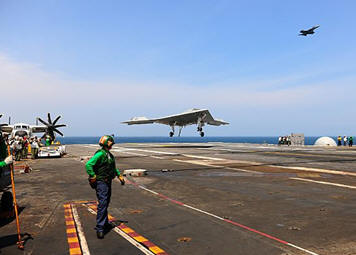|
During today's testing, the X-47B completed the
35-minute transit from Pax River to the carrier and
caught the 3 wire with the aircraft's tailhook. The
arrested landing effectively brought the aircraft from
approximately 145 knots to stop in less than 350 feet. Shortly
after the initial landing, the aircraft was launched off
the ship using the carrier's catapult. The X-47B then
proceeded to execute one more arrested landing.
On
the third approach to Bush the X-47B aircraft self
detected a navigation computer anomaly that required the
air vehicle to transit to the assigned shore based
divert landing site, Wallops Island Air Field. The X-47B
navigated to and landed without incident. "We
have been using the same [carrier] landing technology
for more than 50 years now and the idea that we can take
a large UAV and operate in that environment is
fascinating," said Engdahl.
"Across the entire spectrum of military operations, an
integrated force of manned and unmanned platforms is the
future," said Ray Mabus. "The X-47B's autonomous
arrested landing aboard USS George H.W. Bush shows how
the Navy and Marine Corps are riding the bow wave of
technological advances to create this 21st century
force."
The X-47B spent several weeks aboard aircraft carriers
in recent months. The Navy UCAS program successfully
completed CVN deck operations aboard USS Harry S. Truman
(CVN 75) in December 2012 and aboard Bush in May. During
the May underway period, the X-47B completed its
first-ever catapult launch. Since May, the integrated
test team conducted a number of shore-based arrestments
at Pax River in preparation for the demonstration aboard
the ship.
"We have learned a lot from our flight deck operations,
our shore-based flight test and extensive modeling and
simulation," Engdahl added. "Our team has executed all
major program objectives and developed the concept of
operations and demonstrated technologies for a future
unmanned carrier-based aircraft capability. [Today] we
have proven we can seamlessly integrate unmanned systems
into the carrier environment."
"We have certainly come a long way in the 102 years
since Eugene Ely made the first arrested landing
aboard an aircraft carrier. Naval aviators have
always been at the forefront of operational and
tactical innovation, and today was no exception,"
said Mabus. "People make unmanned aviation possible
and it is people who will provide the fresh thinking
and new ideas so crucial to successes like the X-47B
program and the unmanned aircraft of the future."
|



